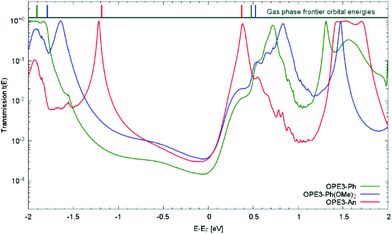 Open Access Article
Open Access ArticleCreative Commons Attribution 3.0 Unported Licence
Correction: Electronic conductance and thermopower of single-molecule junctions of oligo(phenyleneethynylene) derivatives
Hervé
Dekkiche
a,
Andrea
Gemma
b,
Fatemeh
Tabatabaei
c,
Andrei S.
Batsanov
a,
Thomas
Niehaus
*c,
Bernd
Gotsmann
*b and
Martin R.
Bryce
*a
aDepartment of Chemistry, Durham University, Durham, DH1 3LE, UK. E-mail: m.r.bryce@durham.ac.uk
bIBM Research-Zurich, Rueschlikon 8803, Switzerland. E-mail: bgo@zurich.ibm.com
cUniversité Claude Bernard Lyon 1, CNRS, Institut Lumière Matière, Villeurbanne, France. E-mail: thomas.niehaus@univ-lyon1.fr
First published on 18th February 2021
Abstract
Correction for ‘Electronic conductance and thermopower of single-molecule junctions of oligo(phenyleneethynylene) derivatives’ by Hervé Dekkiche et al., Nanoscale, 2020, 12, 18908–18917, DOI: 10.1039/D0NR04413J.
The authors have discovered an error that affects some of the numerical results shown in the original article. In the transport simulations the lead self-energy was not sufficiently converged, which resulted in an underestimated transmission close to the Fermi energy. As such, a 10 × 10 × 10 instead of a 2 × 1 × 1 (original article) k-point sampling has been used in the construction of the lead self-energy. The updated transmission plot (Fig. 7) and corrected values for conductance and Seebeck coefficients (Table 1) are displayed below. These errors do not affect any of the experimental results and discussion or conclusions reported in the paper, only the display of Fig. 7 and Table 1.
| G exp [10−4 G0] | G theo [10−4 G0] | S exp [μV K−1] | S theo [μV K−1] | |
|---|---|---|---|---|
| OPE3-Ph | 0.92 | 1.60 | −11.4 ± 0.5 | −25.6 |
| OPE3-Ph(OMe) 2 | 2.03 | 3.86 | −7.9 ± 1.3 | −27.0 |
| OPE3-An | 1.82 | 3.64 | −8.7 ± 1.6 | −37.1 |
The Royal Society of Chemistry apologises for these errors and any consequent inconvenience to authors and readers.
| This journal is © The Royal Society of Chemistry 2021 |

